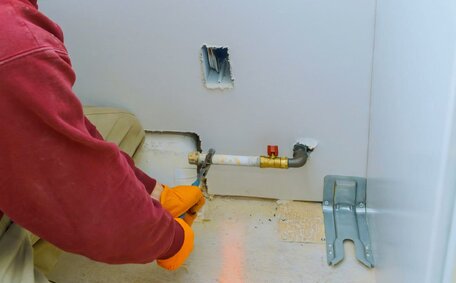What is Trenchless Relining?
Trenchless relining revitalises underground pipes by introducing a resin-soaked liner into the current pipe, hardening to forge a new, continuous pipe within the existing structure.
The most common trenchless relining technique is called cured-in-place pipe lining (CIPP). This involves inserting a felt tube coated with special epoxy resin into the damaged pipe. Once in position, hot water or steam is pumped through the tube, causing the resin to cure and harden inside the damaged drain pipe. This creates a jointless, sturdy new pipe that is securely adhered to the existing pipe walls.
Trenchless drain pipe relining offers major advantages over traditional “dig and replace” pipe repairs. Drummoyne Plumbing, a top plumbing provider in Drummoyne and nearby Sydney areas, embraces appropriate trenchless techniques to reduce inconvenience and environmental impact.
This method provides substantial benefits, notably in preventing extensive property damage:
- No digging or destruction of yards, driveways or landscaping
- Significantly less disruption to traffic and local infrastructure
- Facilitates pipe repairs without harming tree roots or underground services
- Far quicker compared to conventional digging and replacement approaches
- Long-lasting solution that can extend the life of pipes by 50 years or more
With CIPP lining, we rehabilitate pipes in situ, offering homeowners a non-invasive, cost-effective, and environmentally responsible alternative to conventional pipe repairs, avoiding the need for extensive digging.
How Does Trenchless Pipe Relining Work?
The trenchless pipe relining process consists of four key stages:
- Inspection: First, our technicians use a special robotic camera to thoroughly inspect the damaged pipe and identify any issues or blockages. This enables us to determine the exact length and shape of the pipe that requires repair.
- Cleaning: Next, we clean the pipe with high-pressure water jets to remove any built-up debris, grease or mineral deposits. This prepares the pipe surface for optimal bonding with the new liner.
- Pipe Lining Installation: We introduce an epoxy-coated liner into the cleared out pipe via an existing access point such as a manhole. The flexible pipe liner conforms to any shape, diameter or angle. Once in position, we use steam or hot water to activate the epoxy resin and harden the new liner.
- Curing & Finalisation: Finally, we reopen service to the relined pipe once the epoxy liner is fully cured and hardened in place. This creates a durable, watertight new pipe resistant to corrosion and tree roots.
The result is a seamlessly upgraded pipe system that ensures longevity and is achieved efficiently, with minimal disruption to your property and the surrounding area.
Trenchless Pipe Relining Uses Epoxy or Polyester Resin
Trenchless pipe relining primarily uses two types of resin to coat the inner liner before it is inserted into the damaged pipe – epoxy and polyester.
Epoxy resins are favoured for their strong bonding properties and resistance to root intrusion, corrosion, and various chemicals, curing into a hardened, seamless and durable material that can withstand pressure for over five decades.
Epoxy and polyester resin systems offer superior sealing properties against leaks and infiltration and can tolerate high temperatures, making them suitable for hot water systems.
Our team, equipped with expertise, carefully chooses the best resin suited to the specific pipe dimensions, required lifespan, and environmental conditions, ensuring a durable and efficient relining process.
Trenchless Relining Repairs Damaged Pipes Without Excavation
One of the biggest advantages of trenchless drain relining is that it allows our technicians to repair damaged underground pipes without any need to dig up the area.
Unlike traditional excavation methods which require trenches to be dug to access broken pipes, trenchless relining uses small access points to reline pipes from the inside out. This eliminates the need to dig massive holes in order to fix cracked, corroded or blocked drains.
Gaining access through a present cleanout or manhole, we comprehensively clean and evaluate pipe damage with camera equipment. Steam or hot water activates the durable resin coating to form a new, jointless pipe firmly anchored to the old pipe walls.
Trenchless relining eliminates the need for jackhammering driveways or excavating gardens – perfect for the densely constructed Drummoyne region. Offering slight ground interference, it avoids interrupting footpaths, trees and subterranean infrastructure.
Our non-invasive pipe lining methods yield efficient underground drainage repairs without damaging lawns or affecting foundations. Contact Drummoyne Plumbing to learn more about how CIPP trenchless relining can upgrade your pipes with virtually zero disturbance to your property.
When is Trenchless Relining Recommended?
We recommend trenchless relining for repairing damaged underground pipes in the following common situations:
- Pipes under buildings, driveways or hard-to-reach locales where excavation is challenging, risky or highly disruptive
- Cases where preserving trees, landscaping or gardens is a high priority
- Extensive pipe damage that necessitates complete replacement, especially for a compromised drain with standard excavation repairs
- Repairing pipes under busy roads to avoid traffic congestion from roadworks
- Areas with substantial subterranean framework where digging risks damage
- Heritage sites or architecturally sensitive locations
Our minimally invasive CIPP relining process facilitates effective pipe repairs and upgrades while protecting your property from significant damage, making it a specialty of our experienced plumbing service in Drummoyne.
Indications Your Pipes May Need Trenchless Relining
There are several clear signs that your underground pipes could benefit from trenchless relining repairs:
- Frequent blockages: If you experience ongoing clogs or back-ups despite attempts at drain cleaning, damaged pipes likely need repair.
- Leaks or water stains: Cracks and holes in deteriorating pipes often lead to water infiltration and visible stains that could damage your walls or ceilings.
- Sewer gas smells: Catching whiffs of rotten egg odours from drains suggests broken pipes allowing sewer gas to leak into the property.
- Gurgling drains: Strange noises during drainage combined with slow-flowing water indicate partial blockages in damaged pipes.
- Tree root invasion: Slow drains accompanied by visible roots infiltrating pipe joints likely requires professional relining.
- Dips or cracks in the ground: Ground subsidence around pipe locations can imply collapsed drains requiring urgent repair.
For continuous drainage or plumbing issues possibly arising from damaged pipes, arrange a diagnostic inspection with our team. Utilising advanced trenchless technology, we can pinpoint the issue and recommend the most effective solution.
Prevent emergencies before they occur; address even small leaks promptly to avoid major problems. Ensure the safety of your property with Drummoyne Plumbing’s reliable maintenance and repair services.
Benefits of Trenchless Relining vs Traditional Replacement
Cost and Time Savings
Choosing trenchless relining can lead to 30% to 50% in cost savings over pipe replacement, plus downtime shrinks from weeks to just a few days.
Traditional pipe replacement may cost between $400 and $1000 per metre, whereas our trenchless CIPP lining services are priced from $130 to $315 per metre, presenting significant financial benefits.
Minimal Disruption to Property
Trenchless lining necessitates only small access pits instead of extensive trenches, thereby significantly reducing surface disturbance compared to traditional repairs.
The minimally invasive approach maintains landscaping integrity and infrastructure, which is especially beneficial for dense urban environments such as Drummoyne.
Higher Pipe Durability and Lifespan
Lined pipes boast an increased lifespan, generally enduring 50 years beyond traditional pipes, with the robust epoxy or polyester lining securing strong defence against infiltration and decay.
Trenchless CIPP liners have an expected service life of 50-100 years thanks to their exceptional structural strength and chemical resistance.
Lower Environmental Impact
Trenchless relining features highly localised excavation zones, leading to less invasiveness and minimal ecological disruption.
Pipe relining diminishes carbon discharges and material waste, thus safeguarding current infrastructure and the neighboring ecological system – an asset to Drummoyne’s environment.






